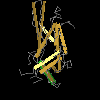?
 
DNA-binding domain of Signal Transducer and Activator of Transcription 3 (STAT3) This family consists of the DNA-binding domain (DBD) of the STAT3 proteins (Signal Transducer and Activator of Transcription 3, or Signal Transduction And Transcription 3). The DNA binding domain has an Ig-like fold. STAT3 plays key roles in vertebrate development and mature tissue function including control of inflammation and immunity. Mutations in human STAT3, especially in the DNA-binding and SH2 domains, are associated with diseases such as autoimmunity, immunodeficiency and cancer. STAT3 regulation is tightly controlled since either inactivation or hyperactivation results in disease. STAT3 activation is stimulated by several cytokines and growth factors, via diverse receptors. For example, IL-6 receptors depend on the tyrosine kinases JAK1 or JAK2, which associate with the cytoplasmic tail of gp130, and results in STAT3 phosphorylation, dimerization, and translocation to the nucleus; this leads to further IL-6 production and up-regulation of anti-apoptotic genes, thus promoting various cellular processes required for cancer progression. Other activators of STAT3 include IL-10, IL-23, and LPS activation of Toll-like receptors TLR4 and TLR9. STAT3 is constitutively activated in numerous cancer types, including over 40% of breast cancers. It has been shown to play a significant role in promoting acute myeloid leukemia (AML) through three mechanisms: promoting proliferation and survival, preventing AML differentiation to functional dendritic cells (DCs), and blocking T-cell function through other pathways. STAT3 also regulates mitochondrion functions, as well as gene expression through epigenetic mechanisms; its activation is induced by overexpression of Bcl-2 via an increase in mitochondrial superoxide. Thus, many of the regulators and functions of JAK-STAT3 in tumors are important therapeutic targets for cancer treatment. |
